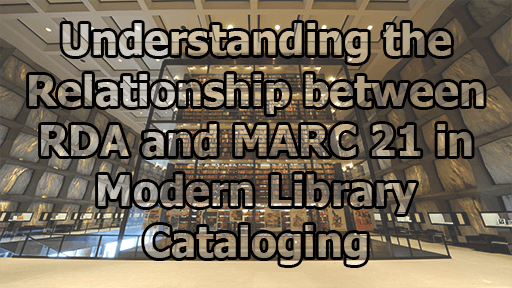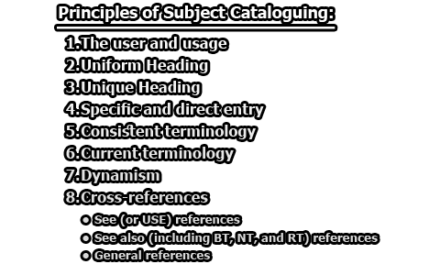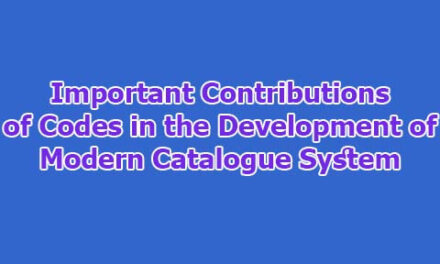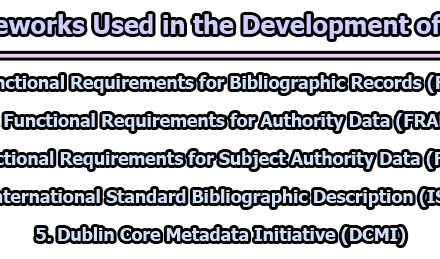Understanding the Relationship between RDA and MARC 21 in Modern Library Cataloging:
RDA (Resource Description and Access) is being developed as a successor to AACR2 as a new content standard for asset description and access. MARC 21 is a communication and exchange format that provides a framework for encoding bibliographic and authoritative information content. It is recognized that RDA descriptions can be encoded using other schemas such as MODS or Dublin Core and that the MARC 21 framework supports encoding descriptions created according to a wide range of content standards. RDA (AACR) and MARC 21, however, are inherently connected, as evidenced by the conventional “MARC display” and MARC input templates in today’s library systems. In the rest of this article, we will explore understanding the relationship between RDA and MARC 21 in modern library cataloging.
Key Features of RDA:
Resource Description and Access (RDA) is an evolving standard poised to supersede AACR2, with a distinct focus on enhancing asset description and access in modern library cataloging. Central to its development are the underlying conceptual models of Functional Requirements for Bibliographic Records (FRBR) and Functional Requirements for Authority Data (FRAD), which drive RDA’s adaptability to object-oriented or entity-related database structures.
- Adaptation to Object-Oriented Database Structures: RDA is strategically designed to align seamlessly with object-oriented database structures, leveraging the efficiency and flexibility inherent in such frameworks. This adaptation extends to the processes of data capture, storage, retrieval, and display. By embracing object-oriented principles, RDA aims to enhance the organization and representation of bibliographic information in a manner that optimally reflects the complex relationships between entities.
- Clear Division Between Data Recording and Presentation: A pivotal feature of RDA’s design philosophy is the establishment of a clear delineation between data recording and presentation. Unlike its predecessor AACR2, RDA prioritizes a modular approach, emphasizing guidelines and instructions specifically tailored for recording data. This division allows for flexibility in the presentation layer, accommodating diverse structures and syntaxes for data storage and display.
- Focus on Entity Characteristics and Relationships: RDA’s primary focus is to provide comprehensive guidelines and instructions for recording data that authentically capture the characteristics and relationships associated with entities, as defined in the FRBR and FRAD models. By centering on entities, RDA aims to create a standardized and robust framework that transcends specific structural or syntactical constraints, ensuring interoperability and adaptability across diverse cataloging environments.
- Purpose of Instructional Guidance: The purpose of RDA’s instructional guidance is to equip catalogers with a set of instructions that can be applied independently of any particular structure or syntax for data storage or display. This approach empowers libraries to tailor their cataloging practices to the unique needs of their user base while maintaining adherence to a standardized set of principles that ensure consistency and coherence in bibliographic records.
The key features of RDA underscore its commitment to adaptability, efficiency, and flexibility in the realm of library cataloging. By aligning with object-oriented database structures and emphasizing a clear division between data recording and presentation, RDA positions itself as a forward-looking standard that accommodates the complexities of modern bibliographic information while providing a unified approach to entity-centric cataloging.
Reasons for Adopting RDA:
The former AACR2 standard, developed in the 1970s, was created for an analog, card catalog environment. Based on the International Standard for Bibliographic Description (ISBD), AACR2 was primarily a display standard, not a content standard like RDA. AACR2 endeavored to display as much book information as possible in the smallest amount of space, employing abbreviations and prescriptive punctuation. In today’s electronic-based library, these space concerns are obsolete, and the focus has shifted to discovery concerns, where abbreviations can impede discovery. RDA addresses this shift by providing guidelines, not rules, that libraries can customize based on the needs of their users and the level of cataloging they can afford to provide.
Some of the reasons for adopting RDA are as follows:
- RDA strives toward becoming an international standard for metadata both inside and outside of the library community.
- Bibliographic records in RDA will be more relevant in an online environment by enabling catalogs to cluster related records to show different manifestations of the same work.
- Special collections item records can be connected to records of facsimiles or circulating copies of the same content, providing better access to the content across multiple platforms.
- Supports the essential user tasks of finding, identifying, and selecting the resource that best fits the users’ needs, and then obtaining that resource.
- To provide guidelines for customization in authority work which becomes even more essential in cataloging.
- It also provides guidelines and instructions for recording data to reflect the characteristics and relationships associated with entities.
- The Virtual International Authority File (VIAF) is used to provide standardized access points to RDA’s more robust data.
- RDA is based on the Functional Requirements for Bibliographic Records (FRBR) relationships using the Functional Requirements for Authority Data (FRAD).
RDA Core Elements and Choices:
A class of guidelines known as “core if” requires certain actions be taken if a particular situation exists, in order to meet RDA core elements. After core requirements are met, catalogers are faced with a number of options, including alternatives from the prescribed guidelines and optional omissions or additions. There are also “or” guidelines, which the Joint Steering Committee views as differing from alternatives in that catalogers must choose one of the given options in order to comply with RDA.
The RDA core elements, MARC tags and subfields where these elements are recorded, and the RDA guidelines for these elements are as follows:
Title Proper
MARC 245 $a $n $p
RDA 2.3.2
Statement of Responsibility relating to title proper
MARC 245 $c
RDA 2.4.2
Edition Statement
MARC 250 $a
RDA 2.5
Serial numbering
MARC 362 $a
RDA 2.6
Publication Information
MARC 264 $a $b $c
RDA 2.8
Extent of Resource
MARC 300 $a
RDA 3.4 (Core if the resource is complete or if the total extent is known)
Content type
MARC 336 $a
RDA 6.9
Media type
MARC 337 $a
RDA 3.2
Carrier type
MARC 338 $a
RDA 3.3
Series
MARC 490 $a $v
RDA 2.12
Identifiers for the Manifestation
MARC 020, 022, 024, 028
RDA 2.15
Issues and/or RDA elements that have implications for MARC 21:
i) General Material Designation/MARC 21 field 245, subfield $h
One widely recognized and long-standing problem in AACR2 has been the use of the GMD to represent content and carrier. Two initiatives have contributed to the current thinking on how to handle content/carrier data. The similarity of the RDA elements to MARC 21 Leader and fixed fields may stimulate an analysis and assessment of the MARC 21 coded data.
ii) MARC 21 (bibliographic) Leader/18 (Descriptive cataloging form); MARC 21 (authority) 008/10 (Descriptive cataloging rules; Description conventions code list): New values will be needed for “RDA”
iii. Terminology: Some RDA terminology differs from that of AACR2:
| AACR2 | RDA |
| Heading | Authorized access point (AAP) |
| Uniform title | Preferred title; conventional collective title |
| Physical description | carrier |
| Sound disc, etc. | Audio disc, etc. |
| Author | Creator (includes composers, librettists, lyricists) |
| Performer | Contributor |
| Chief source | Preferred sources |
| General material designator | Content, media, and carrier type. |
iv) Punctuation: RDA has been designed to establish a clear separation between the presentation and recording of data. Guidelines for presenting RDA content in MARC and ISBD displays (including punctuation) will be given in an appendix. MARBI may wish to reconsider the relationship between content designation and punctuation in MARC.
v) Interdependence: There is some interdependence between RDA and MARC 21 that would be useful for the two communities to discuss:
- The JSC is currently conducting a review of the appendices, including the one on Initial articles, and new articles have been proposed for inclusion. Any changes which result will be referred to LC’s Network Development and MARC Standards Office for inclusion in Initial Definite and Indefinite Articles.
- RDA refers to the use of standard lists to designate roles, such as the MARC Code List for Relators, Sources, Description Conventions and the Rare Book and Manuscript Section (RBMS) list of relator terms.
vi) Abbreviations: RDA generally eschews abbreviations. The primary exceptions are for:
- Units of measurement
- Abbreviations that are regularly used in resources and are commonly understood by users (e.g., “SATB”, “op.”)
- Abbreviations that a resource uses to identify itself (e.g., “BWV” instead of “Bach-Werke Verzeichnis”)
Some of the Abbreviations are given below:
| AACR2 | RDA |
| p. | Pages |
| ca. | Approximately |
| i.e. | that is |
| acc. | Accompanied |
| unacc. | Unaccompanied |
| arr. | Arranged |
| ill. | Illustrations |
| col. | Color |
| facsim. | Facsimile |
| ed. | Edition |
| S.l. | [place of publication not identified] |
| s.n. | [publisher not identified] |
| n.d. | [date of publication not identified] |
Examples of some of changes to abbreviations used in the physical description (extent of item)
| AACR2 | RDA |
| 3 vol. | 3 volumes |
| ca. 200 p. | approximately 200 pages |
| 48 [i.e. 96] p. | 48, that is, 96 pages |
| [16] p. of plates | 16 unnumbered pages of plates |
vii) Dimensions: Examples of changes to abbreviations used in dates in authorized access points representing persons (formerly known as name headings)
| AACR2 | RDA | LC practice (when it varies from RDA) |
| b. 1825 | born 1825 | 1825- |
| d. 1859 | died 1859 | -1859 |
| fl. | flourished | active |
| ca. 1837 | approximately 1837 | – – – – |
| 1836 or 7 | 1836 or 1837 | – – – – |
| 18th cent. | 18th century | – – – – |
Observations on specific elements/issues:
viii) RDA section 1.6 Transcription: RDA section 1.6 instructs one to transcribe an element as it appears following guidelines for capitalization, numerals, etc. Options have been added to provide some flexibility in this area by allowing elements to be transcribed according to in-house manuals/published style manuals or by accepting the element as it appears when it has been scanned, etc., from a digital source. MARBI may wish to consider whether there is a need to distinguish between different approaches to recording data.
ix) RDA sections 2.7 Publication, 2.8 Distribution, 2.9 Manufacture, and 2.10 Production: RDA has defined separate elements for publication, distribution, manufacture and production; each element has separate sub-elements of “name”, “place”, and “date”. MARC 21 field 260 currently uses the same subfields for publication and distribution data. MARBI may wish to consider whether there is a need to distinguish these elements through MARC 21 coding.
x) RDA sections 3.4–3.18 Carrier description elements: RDA has defined a number of aspects of the technical description as separate elements, with a greater level of granularity than is supported in MARC 21 field 300. Additional content designation could be considered to encode this information.
xi) RDA section 2.13 Resource identifier: Final decisions have not yet been made on how to treat standard identifiers and other resource identifiers. However, RDA may broaden the range of standard identifiers for which it gives instructions beyond those currently provided for in specific MARC 21 fields or in the indicator values in field 024.
xii) RDA has elements that are recorded using terms for an English language context, e.g., publisher unknown. It may be useful to identify such elements through MARC 21 encoding. This could facilitate the reuse of records internationally by enabling terms recorded for one language context to be replaced by terms for a different language context.
xiii) RDA’s approach to recording relationships between resources is under review. There may be a need to specify a new MARC content designation to encode relationships not formerly defined in AACR.
In conclusion, the relationship between RDA and MARC 21 in modern library cataloging is intricate and interdependent. RDA, positioned as a successor to AACR2, focuses on enhancing asset description and access in the digital age, aligning seamlessly with object-oriented database structures and emphasizing a clear division between data recording and presentation. The key features of RDA underscore its commitment to adaptability, efficiency, and flexibility in library cataloging. The decision to adopt RDA over AACR2 is driven by the evolving needs of electronic-based libraries, where RDA’s guidelines offer customization options based on user needs and cost considerations. RDA’s core elements and choices, detailed in MARC tags and subfields, provide a standardized framework for recording bibliographic information, offering flexibility within specified guidelines. The analysis of issues and elements impacting MARC 21 highlights the need for ongoing discussions between the RDA and MARC communities to address challenges such as terminology differences, punctuation considerations, and the encoding of relationships between resources. Ultimately, RDA is designed for the digital world, offering a flexible and adaptable approach to resource description and access that aligns with international models and supports user-focused linked data applications.
References:
- https://www.loc.gov/marc/marbi/2007/5chair12.pdf
- https://www.librarianshipstudies.com/2017/07/resource-description-and-access-rda.html
- https://www.loc.gov/marc/RDAinMARC.html
- https://en.wikipedia.org/wiki/Resource_Description_and_Access

Library Lecturer at Nurul Amin Degree College










